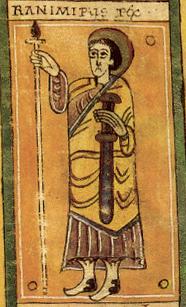Battle of Torrevicente facts for kids
The Battle of Torrevicente was a big fight that happened on Saturday, July 9, 981. It was between two main groups. One group was loyal to the Caliphate of Córdoba, led by a powerful leader named Ibn Abi ‘Amir. The other group was a rebel force led by Galib ibn Abd al-Rahman. Galib had Christian friends helping him, including King Ramiro Garcés of Viguera and Count García Fernández of Castile.
Galib wanted to keep the peace with the Christian kingdoms, like previous leaders had done. But Ibn Abi ‘Amir had a new plan. He wanted to fight more aggressively against the Christians. He had already attacked them seven times in the past three years.
During the battle, both Galib and King Ramiro died. Ibn Abi ‘Amir won the fight. This was his twelfth military campaign. In Muslim writings, it was called the "Campaign of the Victory."
Contents
How We Know About the Battle
Most of what we know about the Battle of Torrevicente comes from old Arabic books. Important writers like Ibn al-Khatib and Ibn Hazm wrote about it. Ibn Hazm's father was even there, fighting with Ibn Abi ‘Amir.
Christian writings from that time don't mention this battle. But one old record says that "the Moors took Atienza" in the year 980. Atienza was a town that was taken from Galib's supporters after they lost at Torrevicente.
The Battle Begins
Ibn Abi ‘Amir and his army left Córdoba on May 11, 981. They marched towards a castle called San Vicente, which is probably Torrevicente near Atienza. Both sides had agreed to meet there for the battle.
The armies arrived on Thursday, July 7, 981. Friday passed without fighting, maybe because it was a holy day for Muslims. But on Saturday, the battle began.
Ibn Abi ‘Amir led the middle part of his army. His right side was made up of Berbers, led by Abu Ya‘far ibn ‘Ali al-Zabi and his brother Yahya. The left side was led by Ahmad ibn Hazm and other commanders.
Galib's Last Stand
Galib was an old man, about 80 years old, but he was still a strong leader. He rode his horse and wore a tall helmet. He led the first attack against Ibn Abi ‘Amir's Berber soldiers. The Berbers quickly broke ranks and ran away.
Galib's attack also broke the left side of Ibn Abi ‘Amir's army. People started looking out for themselves. After scattering both sides of Ibn Abi ‘Amir's army, Galib reportedly prayed. He asked God to help whoever was best suited to lead the Muslims.
Then, Galib rode his horse into a nearby valley. His friends thought he was just taking a break. But when he didn't come back, they went to look for him. They found him dead on the ground, with his horse standing calmly nearby. No one knew exactly how he died.
Victory for Ibn Abi ‘Amir
When Galib's followers found him dead, they believed it was a sign from God. Many of them went to Ibn Abi ‘Amir to ask for peace. Ibn Abi ‘Amir thought it might be a trick. He demanded proof that Galib was truly dead. One person brought Galib's special seal, another brought his hand, and another brought his horse.
After this, Ibn Abi ‘Amir's army strongly defeated Galib's Christian allies. Galib's remaining Muslim soldiers panicked and ran towards Atienza. Ibn Abi ‘Amir's forces chased them. Count García managed to escape, but King Ramiro was found among the dead. Many other Christians also died. Muslim historians saw this battle as a great victory over the Christians.
After his win, Ibn Abi ‘Amir took over Atienza and Calatayud. These were places that had supported Galib. He also led a quick attack into Castile. After 78 days of fighting, he returned to Córdoba in triumph on July 27. He then took the special title al-Manṣūr bi-llāh, which means "victorious through God." Today, Ibn Abi ‘Amir is best known by the name Almanzor, which comes from this title.
Back in Córdoba, Galib's body was treated very badly as a sign of defeat. His skin was filled with cotton and put on a cross at the gate of the palace. His head was also put on a cross at another gate.
Who Was King Ramiro?

There has been some debate about exactly who King Ramiro was and when he died. Old Arabic writings call him "Rudmir ibn San," or Ramiro Sánchez. There was a younger son of Sancho II of Navarre named Ramiro, but he appears in documents from 983 to 991, which is after the battle. He likely died in 992.
Some historians think that "Sánchez" might be a mistake for "Garcés." Ramiro Garcés was the brother of Sancho of Navarre. We don't have any documents from him after 981. Also, he was a king, unlike Ramiro Sánchez.
Some records from August 15, 981, mention a donation made by Sancho II of Pamplona and Urraca Fernández to a monastery. This donation was for property that Ramiro had owned, and it says he was already buried there. However, the bishops listed as witnesses in this document don't all match the year 981. They fit better with the year 991. It's possible that the donations from 981 were confirmed again in 991.
See also
 In Spanish: Batalla de Torrevicente para niños
In Spanish: Batalla de Torrevicente para niños

